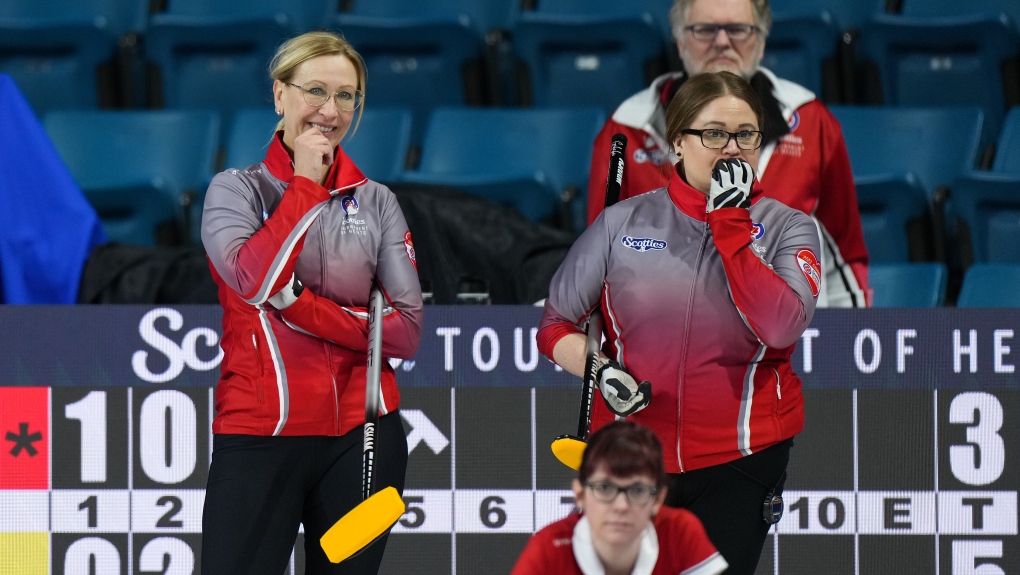
KAMLOOPS, B.C. – Kerry Galusha and Jo-Ann Rizzo are a package deal.
Both are closing in on the end of their competitive curling careers.
The recent revitalization of their Northwest Territories team makes it difficult to walk away, however.
«We’re kind of in the same boat,» Rizzo said. «If we’re going, we’re going together. If we’re staying, we’re staying together.»
In her 15th Canadian women’s curling championship, Galusha skipped the first all-N. W. T. team to make playoffs last year in Thunder Bay, Ont.
Winning three of four games to start this year’s Scotties Tournament of Hearts in Kamloops makes the curlers feel calling it quits might be premature.
«That’s the part that’s reeling us back in,» Rizzo said Monday following a 14-8 win over Newfoundland and Labrador.
The 59-year-old import player from Brantford, Ont., throws fourth stones, with 45-year-old Galusha delivering lead rocks and calling shots.
Margot Flemming and Sarah Koltun, both 29, round out the Yellowknife Curling Club foursome.
Galusha intended the 2022-23 curling season and her 16th Hearts to be her last, but the skip has walked that back.
«It’s hard to quit when I have a good strong team around me,» Galusha said.
«Last year was a dream year. We want to build. I feel this year our pool is tougher, the whole field is tougher, it’s crazy, but we’re excited to play and see what we can do.
«We know we’re underdogs still, but if we come out and make the right shots at the right time and stick together as a team, you never know what can happen.»
Defending champion Kerri Einarson was the lone unbeaten team at 4-0 atop Pool A with a game to play Monday evening against Nova Scotia (3-1).
Galusha, Northern Ontario’s Krista McCarville and Manitoba’s Jennifer Jones co-led Pool B at 3-1.
The top three teams in each pool of nine at the conclusion of the preliminary round Thursday advance to the championship round.
The four Page playoff teams emerge from that group.
Rizzo skipped a team in the 2005 Olympic trials and reached the 2013 trials final as Sherry Middaugh’s third.
Galusha recruited Rizzo in 2019. After a few different lineup configurations, they landed on their current setup.
«It’s given me a little more longevity because if I didn’t join this team I probably would have retired,» Rizzo said. «I’ll just keep trucking along and see where it takes me.»
Rizzo carried the best shooting percentage of all fourth-stone throwers into Monday’s win over Stacie Curtis.
Rizzo’s numbers slipped in the win, but coming through a tight port for a hit to score two for a 2-1 lead in the second end had Newfoundland chasing the rest of the game.
«I feel like I’m throwing better than ever,» Rizzo said.
«Everyone’s giving me good feedback and good information. I’m just going to trust in myself as well as my teammates.»
Einarson thumped Prince Edward Island’s Suzanne Birt 9-2 in the afternoon draw to extend her run of wins.
Three-time national champion Rachel Homan of Ontario dropped to 2-2 in Pool B alongside Quebec’s Laurie St-Georges following a 6-4 loss to Manitoba.
Quebec scored a 9-5 win over Saskatchewan’s Robyn Silvernagle, who fell to 1-3 with P.E.I.
Yukon’s Hailey Birnie beat Casey Scheidegger’s wild card 2 10-3 to put both teams in a three-way tie at 1-2 with New Brunswick’s Andrea Kelly.
Off the ice, Galusha and teammates wear black hoodies featuring a custom design by Indigenous artist Kyra McDonald.
«We asked her design something that represented the north,» Galusha explained. «It has the red hand for missing and murdered Indigenous women.
«Also the polar bear, the sun, because where we live the sun also often doesn’t set.
«I am Gwich’in, so we wanted to incorporate something in the Gwich’in language. It says «one land, many voices.'»
As first reported by CBC, Galusha’s father Fred was taken at age 11 to spend 10 months in a residential school in Iqaluit.
It’s been almost two years since ground-penetrating radar indicated what’s believed to be over 200 graves at the former Indian Residential School in Kamloops.
Similar findings at other former residential schools elsewhere in Canada followed the discovery in Kamloops.
«We just wanted to represent the North and especially it being in Kamloops, Kamloops is kind of the city where Canadians took notice with what happened with the residential schools,» Galusha said.
«We just wanted to do something special coming to curl here.»